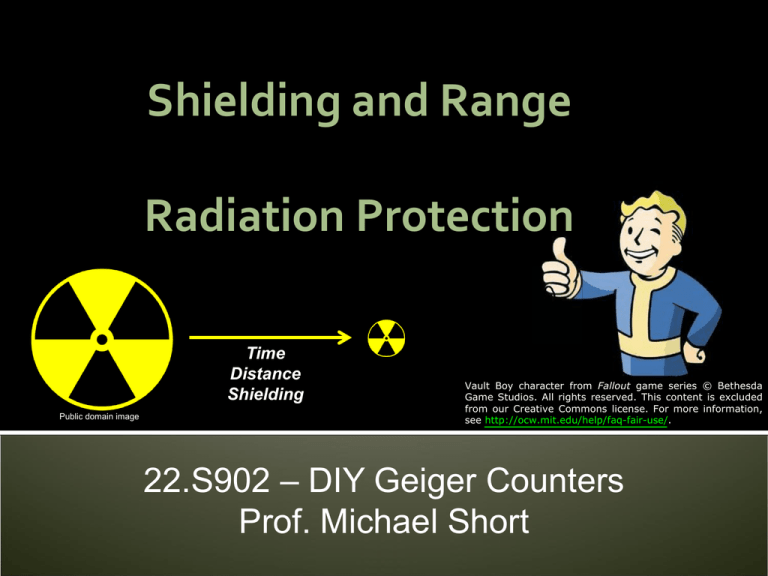
Shielding and Range
Radiation Protection
Time
Distance
Shielding
Public domain image
Vault Boy character from Fallout game series © Bethesda
Game Studios. All rights reserved. This content is excluded
from our Creative Commons license. For more information,
see http://ocw.mit.edu/help/faq-fair-use/.
22.S902 – DIY Geiger Counters
Prof. Michael Short
Question:
What is Vault Boy doing?
Vault Boy character from Fallout game series © Bethesda Game Studios.
All rights reserved. This content is excluded from our Creative Commons
license. For more information, see http://ocw.mit.edu/help/faq-fair-use/.
2
Motivation
Understand how time and distance
decrease exposure rate to radiation
Derive rules of logarithmic attenuation
Characterize different materials in terms of
their shielding efficacy
Design ideal, economical radiation shielding
3
Dose and Time
I hope this one is self-explanatory!
4
Dose and Distance
Assuming a point source of radiation:
Intensity at
surface of sphere
Sphere area
A= 4πr2
I = S2
4πr
I
9
I
4
I
Source strength
S
r
2r
3r
Inverse square law: Doubling the distance from source, the energy
is spread over four times the area, so intensity falls to one-fourth.
Image by MIT OpenCourseWare. After Hyperphysics.
The solid angle subtended by the object of
interest determines dose rate
5
Dose and Distance
The solid angle subtended by the object of
interest determines dose rate
*HLJHUWXEHSKRWRFRXUWHV\RI-HII.H\]HURQ)OLFNU
What is the “object of interest?”
How do you determine if a source is a “point
source?”
6
Dose and Distance
www.prc68.com/I/Rad_Det.shtml
The solid angle subtended by the object of
interest determines dose rate
*HLJHUWXEHSKRWRFRXUWHV\RI-HII.H\]HURQ)OLFNU
If your object’s (or your) solid angle (projected
area) on a sphere of radius r is small, and the
source is small in comparison, its area
approximates the area projected onto the sphere
7
Dose and Distance
http://en.wikipedia.org/wiki/Steradian
The solid angle subtended by the object of
interest determines dose rate
Public domain images.
One
steradian
If your object’s (or your) distance from the sphere
is large, and its area is small, then 𝑟𝑟 ≫ ℎ, and
you can approximate object area as sphere area
8
Dose and Distance Calculation
*HLJHUWXEHSKRWRFRXUWHV\RI-HII.H\]HURQ)OLFNU
This source has 5μCi of activity, and our
SBM-20 tube is 1m away:
5 𝜇𝜇𝐶𝐶𝐶𝐶
𝐵𝐵𝐵𝐵
10
𝐼𝐼 =
= 3.7 ∙ 10
4𝜋𝜋 𝑆𝑆𝑟𝑟
𝐶𝐶𝐶𝐶
5 ∙ 10−6 𝐶𝐶𝐶𝐶
𝛾𝛾 − 𝑟𝑟𝑟𝑟𝑟𝑟𝑟𝑟
4
= 1.47 ∙ 10
4𝜋𝜋 𝑆𝑆𝑟𝑟
𝑆𝑆𝑟𝑟 − 𝑟𝑟
Ignoring shielding of air, the tube wall, etc.:
Tube diagram © source unknown. All rights reserved. This content is
excluded from our Creative Commons license. For more information,
see http://ocw.mit.edu/help/faq-fair-use/.
𝐴𝐴 ≈ 0.01𝑚𝑚 × 0.108𝑚𝑚 ≈ 0.00108𝑚𝑚2
9
Dose and Distance Calculation
*HLJHUWXEHSKRWRFRXUWHV\RI-HII.H\]HURQ)OLFNU
Ignoring shielding of air, the tube wall, etc.:
Tube diagram © source unknown. All rights reserved. This content is
excluded from our Creative Commons license. For more information,
see http://ocw.mit.edu/help/faq-fair-use/.
𝐴𝐴 ≈ 0.01𝑚𝑚 × 0.108𝑚𝑚 ≈ 0.00108𝑚𝑚2
One Steradian (Sr) on a 1m radius sphere is 1m2:
Φ̇ = 1.47 ∙
104
𝛾𝛾 − 𝑟𝑟𝑟𝑟𝑟𝑟𝑟𝑟
𝑆𝑆𝑟𝑟 − 𝑟𝑟
1 𝑆𝑆𝑟𝑟
𝑚𝑚2
0.00108𝑚𝑚2
𝛾𝛾 − 𝑟𝑟𝑟𝑟𝑟𝑟𝑟𝑟
= 15.88
𝑟𝑟
10
Repeat the Question:
What is Vault Boy doing?
Vault Boy character from Fallout game series © Bethesda
Game Studios. All rights reserved. This content is excluded
from our Creative Commons license. For more information,
see http://ocw.mit.edu/help/faq-fair-use/.
11
Repeat the Question:
What is Vault Boy doing?
He is estimating a solid angle!
Vault Boy character from Fallout game series © Bethesda
Game Studios. All rights reserved. This content is excluded
from our Creative Commons license. For more information,
see http://ocw.mit.edu/help/faq-fair-use/.
12
What About Shielding?
Turner, p. 188 (2007)
Say N gamma rays reach a distance x without interaction.
Define a constant of proportionality relating the number that
interact in a distance dx:
x
𝑑𝑑𝑑𝑑 = −µ𝑑𝑑𝑑𝑑𝑁𝑁
This constant (µ) is the linear
attenuation coefficient. Solve the
differential equation to get:
No
dx
N(x)
Image by MIT OpenCourseWare. After Turner (2007).
𝑑𝑑𝑑𝑑
= −𝜇𝜇𝑑𝑑𝑁𝑁
𝑑𝑑
𝑑𝑑 = 𝑑𝑑0 @ 𝑁𝑁 = 0
ln 𝑑𝑑 = −𝜇𝜇𝑁𝑁 + 𝑐𝑐
𝑐𝑐 = 𝑙𝑙𝑙𝑙 𝑑𝑑0
𝑑𝑑 𝑁𝑁 = 𝑑𝑑0 𝑒𝑒 −𝜇𝜇𝑥𝑥
13
Attenuation Coefficients
Turner, p. 190 (2007)
Note µ has units of
cm-1,
yet tables give values in units of
𝑐𝑐𝑐𝑐2
𝑔𝑔
Must multiply by the
material density!
Source: Morgan, K. Z., and J. E. Turner, eds. Principles of Radiation Protection. Wiley, 1967.
© John Wiley & Sons. All rights reserved. This content is excluded from our Creative
Commons license. For more information, see http://ocw.mit.edu/help/faq-fair-use/.
14
Additive Attenuation Coefficients
How do you deal with multicomponent materials?
Composites, alloys, foams, concrete…
𝑑𝑑 𝑁𝑁 = 𝑑𝑑0
𝜇𝜇
−
𝜌𝜌𝑥𝑥
𝜌𝜌
𝑒𝑒
𝑑𝑑 𝑁𝑁 = 𝑑𝑑0 𝑒𝑒
− ∑𝑛𝑛
𝑖𝑖=1
𝜇𝜇
𝜌𝜌 𝑥𝑥
𝜌𝜌 𝑖𝑖 𝑖𝑖
Each component i combines additively in the exponential
Now, where to find values of
𝜇𝜇
𝜌𝜌
?
http://www.nist.gov/pml/data/xraycoef/index.cfm
NIST (National Institute of Standards and Technology)
maintains an active database!
15
Example: Cheap Shielding
What makes better shielding, plastic or bacon grease?
http://www.nist.gov/pml/data/xraycoef/index.cfm
Public domain images.
About the same! Why???
16
Example: Cheap Shielding
What makes better shielding, concrete or leaded glass?
http://www.nist.gov/pml/data/xraycoef/index.cfm
Public domain images.
It depends on the energy!
17
What About Energy Degradation?
Turner, p. 188 (2007)
You can ignore this for “good geometries” and gammas
x
Narrow Beam
d
Detector
R
d<<R
Image by MIT OpenCourseWare.
Assume that all gammas which interact leave the beam
18
Thinking About the Lab
How will you determine how many gammas interact with
your Geiger counter?
Air
Plastic
Air
Gases Who Cares
Brass Brass
19
20
MIT OpenCourseWare
http://ocw.mit.edu
22.S902 Do-It-Yourself (DIY) Geiger Counters
January IAP 2015
For information about citing these materials or our Terms of Use, visit: http://ocw.mit.edu/terms.

